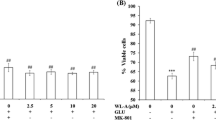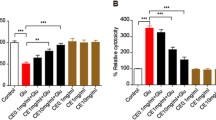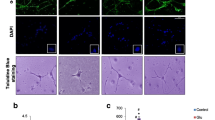Abstract
Hydroxysafflor yellow A (HSYA) is a component of the flower Carthamus tinctorius L. that elicits neuroprotective effects in vivo and in vitro. The purpose of this study was to investigate pharmacological properties of HSYA on neurotoxicity of glutamate in primary cultured rat cortical neurons along with its possible mechanism of action. After challenge with N-methyl-d-aspartate (NMDA, 100 μM) for 30 min, loss of cell viability and excessive apoptotic cell death were observed in cultured cortical neurons. However, the excitotoxic neuronal death was attenuated markedly by HSYA treatment. Western blot analysis revealed that HSYA decreased expression of Bax and rescued the balance of pro-and anti-apoptotic proteins. In addition, HSYA significantly reversed up-regulation of NR2B-containing NMDA receptors by exposure to NMDA, while it did not affect the expression of NR2A-containing NMDA receptors. These finding suggest that HSYA protects cortical neurons, at least partially, from inhibiting the expression NR2B-containing NMDA receptors and by regulating Bcl-2 family.





Similar content being viewed by others
References
Ji DB, Zhang LY, Li CL, Ye J, Zhu HB (2009) Effect of hydroxysafflor yellow A on human umbilical vein endothelial cells under hypoxia. Vascul Pharmacol 50:137–145
Wang C, Ma H, Zhang S, Wang Y, Liu J, Xiao X (2009) Safflor yellow B suppresses pheochromocytoma cell (PC12) injury induced by oxidative stress via antioxidant system and Bcl-2/Bax pathway. Naunyn Schmiedebergs Arch Pharmacol 380:135–142
Wang C, Zhang D, Li G, Liu J, Tian J, Fu F, Liu K (2007) Neuroprotective effects of safflor yellow B on brain ischemic injury. Exp Brain Res 177:533–539
Ji DB, Zhu MC, Zhu B, Zhu YZ, Li CL, Ye J, Zhu HB (2008) Hydroxysafflor yellow A enhances survival of vascular endothelial cells under hypoxia via upregulation of the HIF-1 alpha-VEGF pathway and regulation of Bcl-2/Bax. J Cardiovasc Pharmacol 52:191–202
Ye SY, Gao WY (2008) Hydroxysafflor yellow A protects neuron against hypoxia injury and suppresses inflammatory responses following focal ischemia reperfusion in rats. Arch Pharm Res 31:1010–1015
Zhu H, Wang Z, Ma C, Tian J, Fu F, Li C, Guo D, Roeder E, Liu K (2003) Neuroprotective effects of hydroxysafflor yellow A: in vivo and in vitro studies. Planta Med 69:429–433
Wei X, Liu H, Sun X, Fu F, Zhang X, Wang J, An J, Ding H (2005) Hydroxysafflor yellow A protects rat brains against ischemia-reperfusion injury by antioxidant action. Neurosci Lett 386:58–62
Du Y, Bales KR, Dodel RC, Hamilton-Byrd E, Horn JW, Czilli DL, Simmons LK, Ni B, Paul SM (1997) Activation of a caspase 3-related cysteine protease is required for glutamate-mediated apoptosis of cultured cerebellar granule neurons. Proc Natl Acad Sci USA 94:11657–11662
Brennan AM, Won Suh S, Joon Won S, Narasimhan P, Kauppinen TM, Lee H, Edling Y, Chan PH, Swanson RA (2009) NADPH oxidase is the primary source of superoxide induced by NMDA receptor activation. Nat Neurosci 12:857–863
Stanika RI, Pivovarova NB, Brantner CA, Watts CA, Winters CA, Andrews SB (2009) Coupling diverse routes of calcium entry to mitochondrial dysfunction and glutamate excitotoxicity. Proc Natl Acad Sci USA 106:9854–9859
Arundine M, Tymianski M (2003) Molecular mechanisms of calcium-dependent neurodegeneration in excitotoxicity. Cell Calcium 34:325–337
Hardingham GE, Bading H (2003) The Yin and Yang of NMDA receptor signalling. Trends Neurosci 26:81–89
Monyer H, Burnashev N, Laurie DJ, Sakmann B, Seeburg PH (1994) Developmental and regional expression in the rat brain and functional properties of four NMDA receptors. Neuron 12:529–540
Loftis JM, Janowsky A (2003) The N-methyl-d-aspartate receptor subunit NR2B: localization, functional properties, regulation, and clinical implications. Pharmacol Ther 97:55–85
Nicoll RA, Malenka RC (1999) Expression mechanisms underlying NMDA receptor-dependent long-term potentiation. Ann N Y Acad Sci 868:515–525
Malenka RC, Nicoll RA (1993) NMDA-receptor-dependent synaptic plasticity: multiple forms and mechanisms. Trends Neurosci 16:521–527
Bliss TV, Collingridge GL (1993) A synaptic model of memory: long-term potentiation in the hippocampus. Nature 361:31–39
Hardingham GE, Fukunaga Y, Bading H (2002) Extrasynaptic NMDARs oppose synaptic NMDARs by triggering CREB shut-off and cell death pathways. Nat Neurosci 5:405–414
Wahl AS, Buchthal B, Rode F, Bomholt SF, Freitag HE, Hardingham GE, Ronn LC, Bading H (2009) Hypoxic/ischemic conditions induce expression of the putative pro-death gene Clca1 via activation of extrasynaptic N-methyl-d-aspartate receptors. Neuroscience 158:344–352
Sattler R, Xiong Z, Lu WY, MacDonald JF, Tymianski M (2000) Distinct roles of synaptic and extrasynaptic NMDA receptors in excitotoxicity. J Neurosci 20:22–33
Liu Y, Wong TP, Aarts M, Rooyakkers A, Liu L, Lai TW, Wu DC, Lu J, Tymianski M, Craig AM, Wang YT (2007) NMDA receptor subunits have differential roles in mediating excitotoxic neuronal death both in vitro and in vivo. J Neurosci 27:2846–2857
Zhou M, Baudry M (2006) Developmental changes in NMDA neurotoxicity reflect developmental changes in subunit composition of NMDA receptors. J Neurosci 26:2956–2963
Krapivinsky G, Krapivinsky L, Manasian Y, Ivanov A, Tyzio R, Pellegrino C, Ben-Ari Y, Clapham DE, Medina I (2003) The NMDA receptor is coupled to the ERK pathway by a direct interaction between NR2B and RasGRF1. Neuron 40:775–784
Feigin VL (2007) Herbal medicine in stroke: does it have a future? Stroke 38:1734–1736
Harvey AL (1999) Medicines from nature: are natural products still relevant to drug discovery? Trends Pharmacol Sci 20:196–198
Shen H, Yuan Y, Ding F, Liu J, Gu X (2008) The protective effects of Achyranthes bidentata polypeptides against NMDA-induced cell apoptosis in cultured hippocampal neurons through differential modulation of NR2A-and NR2B-containing NMDA receptors. Brain Res Bull [Epub ahead of print]
Lee J, Son D, Lee P, Kim SY, Kim H, Kim CJ, Lim E (2003) Alkaloid fraction of Uncaria rhynchophylla protects against N-methyl-d-aspartate-induced apoptosis in rat hippocampal slices. Neurosci Lett 348:51–55
Sun X, Chan LN, Gong X, Sucher NJ (2003) N-methyl-d-aspartate receptor antagonist activity in traditional Chinese stroke medicines. Neurosignals 12:31–38
McInnis J, Wang C, Anastasio N, Hultman M, Ye Y, Salvemini D, Johnson KM (2002) The role of superoxide and nuclear factor-kappaB signaling in N-methyl-d-aspartate-induced necrosis and apoptosis. J Pharmacol Exp Ther 301:478–487
Wang H, Wu LJ, Kim SS, Lee FJ, Gong B, Toyoda H, Ren M, Shang YZ, Xu H, Liu F, Zhao MG, Zhuo M (2008) FMRP acts as a key messenger for dopamine modulation in the forebrain. Neuron 59:634–647
Brewer GJ, Torricelli JR, Evege EK, Price PJ (1993) Optimized survival of hippocampal neurons in B27-supplemented Neurobasal, a new serum-free medium combination. J Neurosci Res 35:567–576
Behbahani H, Rickle A, Concha H, Ankarcrona M, Winblad B, Cowburn RF (2005) Flow cytometry as a method for studying effects of stressors on primary rat neurons. J Neurosci Res 82:432–441
Chen L, Liu JC, Zhang XN, Guo YY, Xu ZH, Cao W, Sun XL, Sun WJ, Zhao MG (2008) Down-regulation of NR2B receptors partially contributes to analgesic effects of Gentiopicroside in persistent inflammatory pain. Neuropharmacology 54:1175–1181
Chen X, Liu J, Gu X, Ding F (2008) Salidroside attenuates glutamate-induced apoptotic cell death in primary cultured hippocampal neurons of rats. Brain Res 1238:189–198
von Engelhardt J, Coserea I, Pawlak V, Fuchs EC, Kohr G, Seeburg PH, Monyer H (2007) Excitotoxicity in vitro by NR2A-and NR2B-containing NMDA receptors. Neuropharmacology 53:10–17
Sinor JD, Du S, Venneti S, Blitzblau RC, Leszkiewicz DN, Rosenberg PA, Aizenman E (2000) NMDA and glutamate evoke excitotoxicity at distinct cellular locations in rat cortical neurons in vitro. J Neurosci 20:8831–8837
Evstratova AA, Mironova EV, Dvoretskova EA, Antonov SM (2009) Apoptosis and the receptor specificity of its mechanisms during the neurotoxic action of glutamate. Neurosci Behav Physiol 39:353–362
Bindokas VP, Jordan J, Lee CC, Miller RJ (1996) Superoxide production in rat hippocampal neurons: selective imaging with hydroethidine. J Neurosci 16:1324–1336
Hyrc K, Handran SD, Rothman SM, Goldberg MP (1997) Ionized intracellular calcium concentration predicts excitotoxic neuronal death: observations with low-affinity fluorescent calcium indicators. J Neurosci 17:6669–6677
Antonsson B (2004) Mitochondria and the Bcl-2 family proteins in apoptosis signaling pathways. Mol Cell Biochem 256–257:141–155
Tenneti L, Lipton SA (2000) Involvement of activated caspase-3-like proteases in N-methyl-d-aspartate-induced apoptosis in cerebrocortical neurons. J Neurochem 74:134–142
Schinder AF, Olson EC, Spitzer NC, Montal M (1996) Mitochondrial dysfunction is a primary event in glutamate neurotoxicity. J Neurosci 16:6125–6133
Schelman WR, Andres RD, Sipe KJ, Kang E, Weyhenmeyer JA (2004) Glutamate mediates cell death and increases the Bax to Bcl-2 ratio in a differentiated neuronal cell line. Brain Res Mol Brain Res 128:160–169
Gu B, Nakamichi N, Zhang WS, Nakamura Y, Kambe Y, Fukumori R, Takuma K, Yamada K, Takarada T, Taniura H, Yoneda Y (2009) Possible protection by notoginsenoside R1 against glutamate neurotoxicity mediated by N-methyl-d-aspartate receptors composed of an NR1/NR2B subunit assembly. J Neurosci Res 87:2145–2156
Acknowledgments
The authors gratefully acknowledged the financial support of National Natural Science Foundation of China (No. 30670684, 30672662, 30770686).
Author information
Authors and Affiliations
Corresponding authors
Additional information
Qi Yang, Zhi-Fu Yang and Shui-Bin Liu, contributed equally to this work.
Rights and permissions
About this article
Cite this article
Yang, Q., Yang, ZF., Liu, SB. et al. Neuroprotective Effects of Hydroxysafflor Yellow A Against Excitotoxic Neuronal Death Partially Through Down-Regulation of NR2B-Containing NMDA Receptors. Neurochem Res 35, 1353–1360 (2010). https://doi.org/10.1007/s11064-010-0191-6
Accepted:
Published:
Issue Date:
DOI: https://doi.org/10.1007/s11064-010-0191-6




